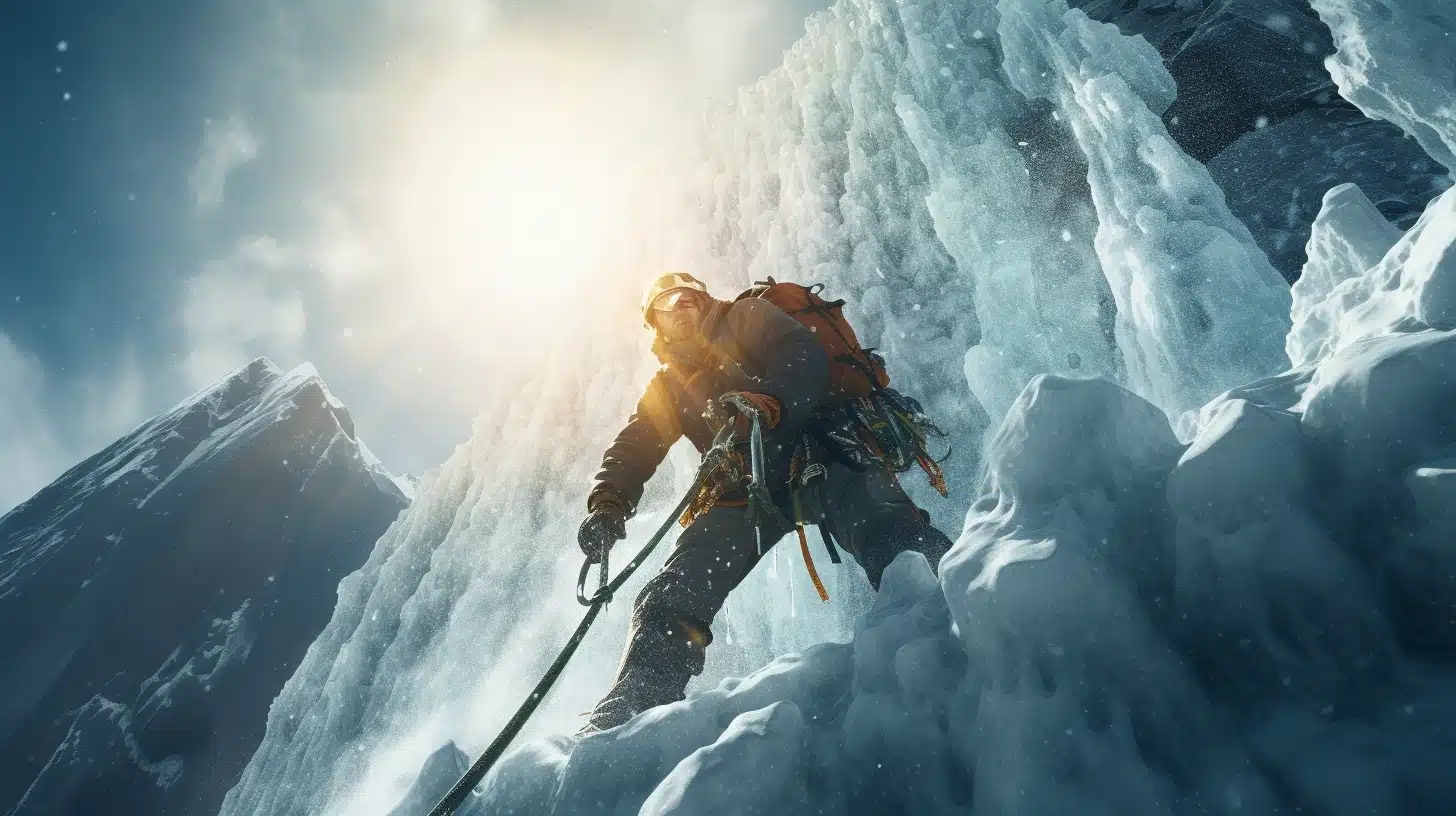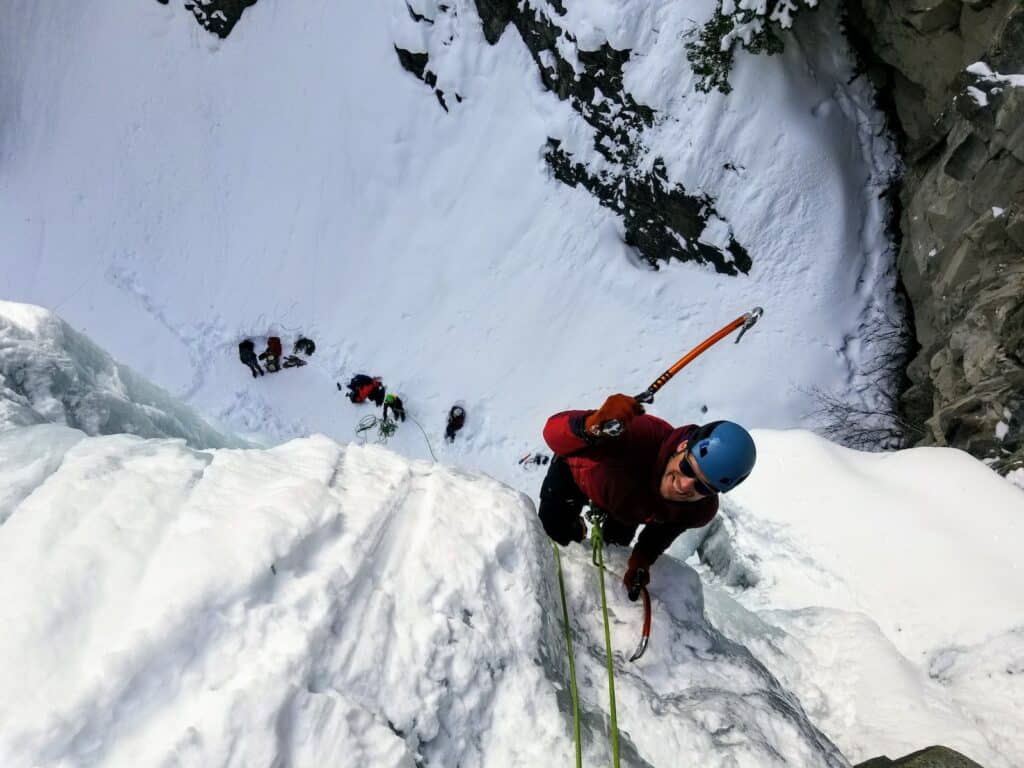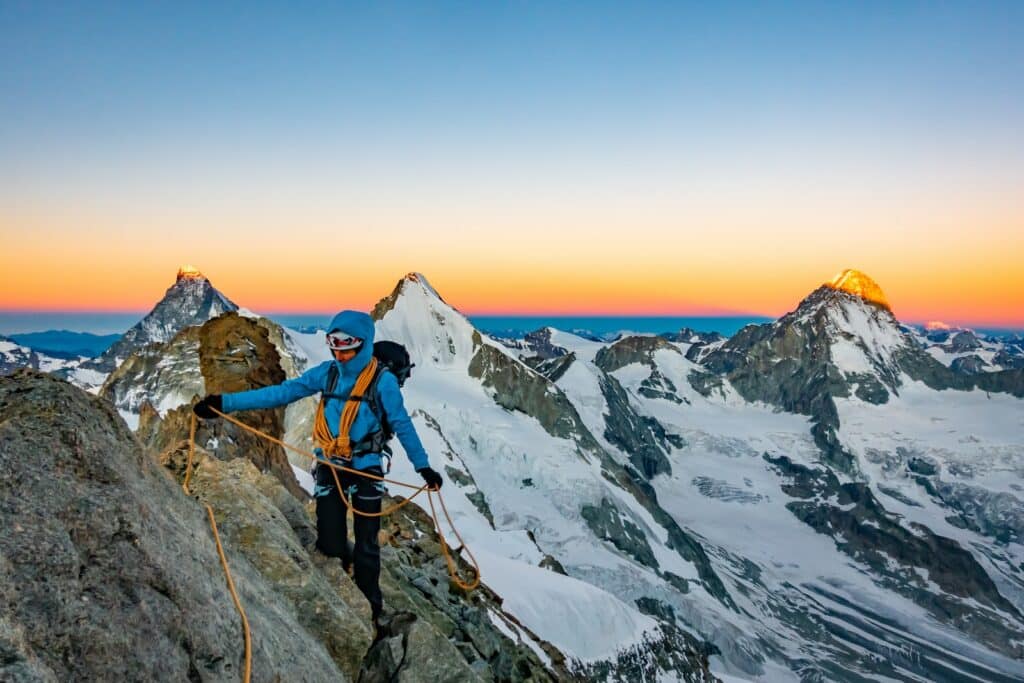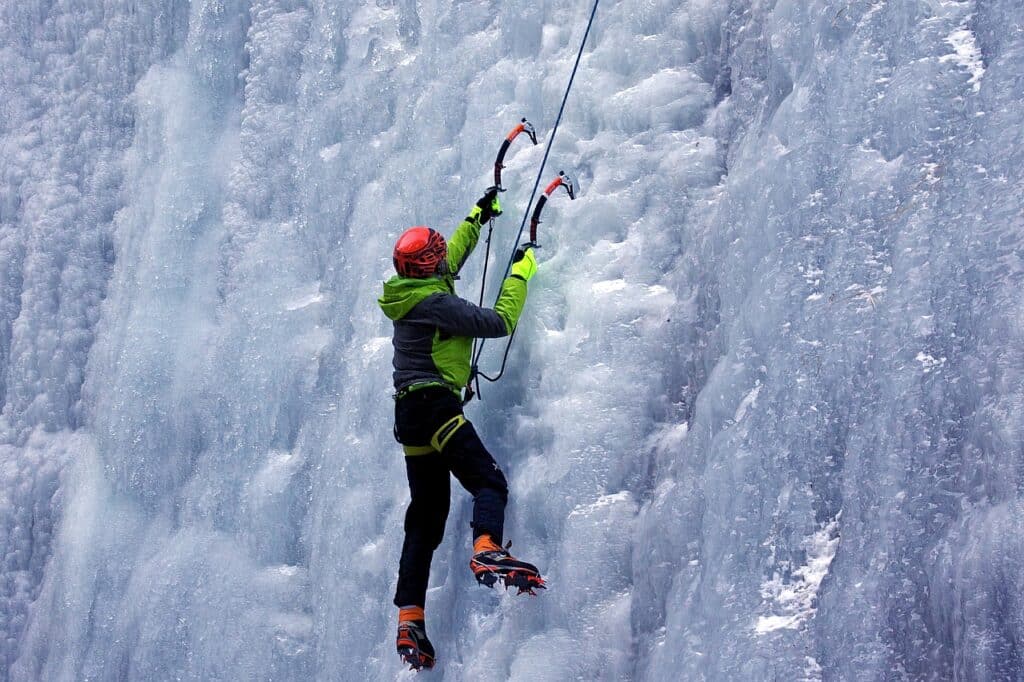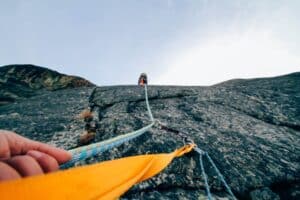Table of Contents
ToggleIntroduction to Ice Climbing
Ice climbing is a thrilling and challenging outdoor activity that involves ascending frozen waterfalls, ice formations, and glaciers using specialized equipment and techniques. It offers a unique and exhilarating experience for climbers of all skill levels.
What is Ice Climbing?
Ice climbing is a type of mountaineering activity that requires climbers to ascend steep ice formations using specialized equipment such as ice axes, crampons, and helmets. It combines elements of rock climbing with the added challenge of climbing on ice.
Ice climbing routes vary in difficulty and can range from short vertical walls to long, complex ice formations. Climbers use ice tools (ice axes) to penetrate the ice and crampons (metal spikes attached to boots) to provide traction on the slippery surface. The climber progresses by kicking their crampons into the ice and using their ice axes to pull themselves upward.
Ice Climbing vs. Rock Climbing
While ice climbing and rock climbing share similarities, there are distinct differences between the two disciplines. Ice climbing requires climbers to navigate frozen surfaces, whereas rock climbing typically involves ascending natural rock formations.
The main difference lies in the nature of the climbing surface. In rock climbing, climbers rely on the natural features of the rock, such as cracks, ledges, and holds, to ascend. In ice climbing, climbers rely on the frozen ice formations, which can be unpredictable and ever-changing.
Ice climbing can be more dangerous than rock climbing due to the inherent risks associated with ice formations, such as unstable ice, avalanches, and falling ice. It requires specific technical skills and equipment, including ice screws, ice tools, and crampons, to safely ascend and protect oneself on ice formations.
Both ice climbing and rock climbing require physical strength, endurance, and mental focus. However, ice climbing demands additional skills such as assessing ice conditions, managing rope systems, and understanding ice protection techniques.
Ice climbing offers a unique and challenging experience for climbers seeking to push their limits and explore new heights. It combines the excitement of climbing with the beauty and awe-inspiring nature of frozen landscapes. Whether you’re a beginner or an experienced climber, ice climbing provides a thrilling adventure that will test your skills and leave you with unforgettable memories.
Ice Climbing Techniques
When it comes to ice climbing, mastering the essential techniques is crucial for a safe and successful ascent. Ice climbing involves ascending frozen waterfalls and ice formations using specialized equipment and techniques. Let’s explore the essential techniques for ice climbing and the climbing tools and equipment you’ll need.
Essential Techniques for Ice Climbing
- Kicking Steps: Ice climbers use their crampons to kick steps into the ice. This technique provides secure footing and allows climbers to ascend the ice efficiently. It’s important to kick with the front points of the crampons to maximize traction.
- Ice Tool Placement: Proper placement of ice tools is vital for stability and progress. Climbers should aim to sink the picks of their ice tools deeply into the ice, ensuring a solid grip. The angle and direction of the swing can vary depending on the ice conditions.
- Weight Transfer: Ice climbers need to shift their weight from one foot to the other as they ascend. This technique helps in maintaining balance and stability on the ice. It’s important to practice proper weight distribution to prevent fatigue and maintain control.
- Resting Stances: Finding resting stances during an ice climb is crucial for conserving energy. Climbers should look for areas with secure footing and use their ice tools to create stable positions. Taking breaks at resting stances allows climbers to recover and plan their next moves.
- Ice Screw Placement: Ice screws are essential for protection on an ice climb. Proper technique for placing ice screws involves precision and strength. Climbers should practice drilling the screws into secure ice and using them to create anchor points for protection.
Climbing Tools and Equipment
Ice climbing requires specialized tools and equipment to safely ascend ice formations. Some of the essential climbing tools and equipment for ice climbing include:
- Ice Axes: Ice axes are used for gripping and stabilizing the ice. They typically have a curved shaft and a pick on one end for penetrating the ice.
- Crampons: Crampons are metal attachments that fit onto the boots and provide traction on the ice. They have sharp points or spikes that grip the ice surface.
- Ice Screws: Ice screws are used for creating anchor points and protection on the ice. They are threaded into the ice and provide a secure attachment for ropes and carabiners.
- Harnesses: Harnesses are worn around the waist and thighs and are used to attach climbers to ropes for safety.
- Helmets: Helmets are essential for protecting the head from falling ice or other objects during the climb.
- Boots: Ice climbing boots provide insulation, support, and traction on the ice. They are designed to keep feet warm and dry in cold and wet conditions.
Understanding and practicing proper ice climbing techniques, along with using the appropriate climbing tools and equipment, is essential for a safe and enjoyable ice climbing experience. Whether you’re a beginner or an experienced climber, always prioritize safety and continue to improve your skills through training and experience. Stay tuned for more tips and information on ice climbing in our upcoming sections.
Ice Climbing Safety
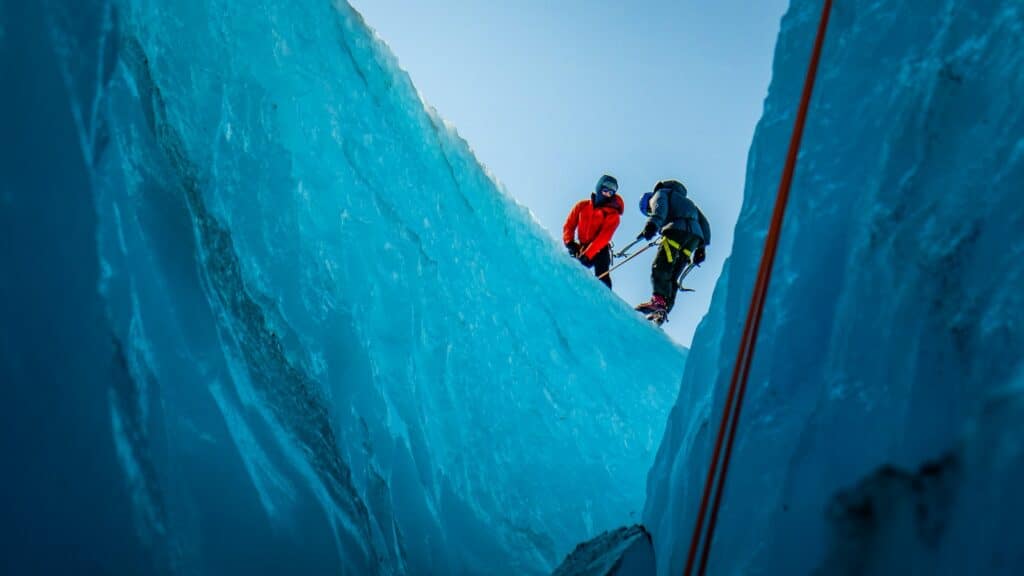
When it comes to ice climbing, safety should always be a top priority. Ice climbing can be more dangerous than rock climbing due to the inherent risks associated with ice formations, such as unstable ice, avalanches, and falling ice. To ensure a safe and enjoyable ice climbing experience, it’s essential to take proper safety precautions and choose the right gear.
Safety Precautions for Ice Climbing
- Proper Training and Experience: Ice climbing requires specific technical skills and knowledge. It is crucial to receive proper training from a qualified instructor and gain experience in ice climbing techniques, such as using ice screws for protection and understanding ice conditions. Consider taking ice climbing courses or hiring a guide to learn the necessary skills and gain confidence on the ice.
- Assess Ice Conditions: Before heading out for an ice climbing adventure, it’s important to assess ice conditions. Check for recent weather changes, evaluate the stability of the ice, and be aware of any potential hazards, such as loose or brittle ice. Stay updated on local ice climbing conditions through guidebooks, online forums, or local climbing organizations.
- Use Reliable Anchors and Protection: Proper use of ice screws, ice tools, and other protection devices is essential for safety during ice climbing. Practice proper technique for placing ice screws, as it requires precision and strength. Ensure that anchors are secure and reliable before proceeding with the climb.
- Communicate and Climb with a Partner: Ice climbing is best done with a partner. Communication is key to ensure safety on the ice. Establish clear communication signals and regularly check in with your climbing partner. Climbing with a partner also allows for assistance in case of an emergency.
- Wear Proper Safety Gear: Always wear a helmet to protect your head from falling ice or accidental impacts. Dress appropriately for the weather conditions, including insulated clothing and waterproof layers. Use gloves specifically designed for ice climbing to provide optimum grip and protection for your hands. Eye protection, such as goggles or sunglasses, is also important to shield your eyes from ice particles.
Choosing the Right Gear for Safety
Selecting the right gear is crucial for safety during ice climbing. Here are some essential items to consider:
- Crampons: Crampons are essential for traction on icy surfaces. Choose crampons that are compatible with your boots and have sharp, well-maintained points for secure footing on the ice. Check out our guide on ice climbing crampons for more information.
- Ice Tools: Ice tools, also known as ice axes, are used for self-arrest, balance, and stability on the ice. Look for ice climbing axes that fit your hand comfortably and have durable picks and shafts. Visit our article on ice climbing axes to learn more about different options.
- Harness: A harness is an essential piece of equipment for ice climbing. Look for a harness specifically designed for ice climbing that offers a comfortable fit and has ample gear loops for carrying ice screws, carabiners, and other climbing gear. Check out our guide on ice climbing harnesses for more information.
- Helmet: Protecting your head is crucial in ice climbing. Choose a helmet designed for climbing that fits securely and provides adequate coverage. The helmet should be able to withstand impacts from falling ice or accidental falls. Explore our article on ice climbing helmets for more details.
- Safety Gear: Additional safety gear includes ice screws, slings, carabiners, and ropes. These items are essential for building anchors, creating belay systems, and providing protection on the climb. Visit our guide on ice climbing gear and ice climbing equipment for comprehensive information on the gear needed for ice climbing.
By following proper safety precautions and using the appropriate gear, you can enjoy the thrill of ice climbing while minimizing the risks involved. Always prioritize your safety and the safety of others on the ice. Stay informed, practice safe climbing techniques, and be prepared for changing conditions to make the most of your ice climbing adventures.
Ice Climbing Locations
When it comes to ice climbing, location plays a crucial role in the overall experience. Certain destinations offer breathtaking landscapes and ideal conditions for ice climbing. In this section, we will explore some of the best destinations for ice climbing and highlight notable ice climbing spots.
Best Destinations for Ice Climbing
- Canada’s Rocky Mountains: Canada’s Rocky Mountains offer some of the best ice climbing and bouldering destinations in the world. Areas like Banff National Park, Canmore, and Kananaskis Country provide a wide range of ice climbing opportunities for climbers of all skill levels. The region is known for its stunning frozen waterfalls and challenging ice routes. For more information, check out our article on best ice climbing destinations.
- Ouray Ice Park, Colorado, USA: The Ouray Ice Park is a man-made ice climbing park located in Colorado. It attracts climbers from all over the world due to its extensive offerings of over 200 ice and mixed climbs. The park’s accessibility and diverse climbing routes make it a popular destination for ice climbers and boulderers alike. Learn more about this unique climbing spot at our article on best ice climbing destinations.
- Norway: Norway is renowned for its stunning ice climbing destinations. Rjukan and Lofoten are two notable locations that offer incredible ice climbing and bouldering opportunities. Rjukan is famous for its frozen waterfalls and challenging ice routes, while Lofoten provides a unique mix of climbing options set amidst a picturesque coastal landscape. To discover more about ice climbing in Norway, visit our article on best ice climbing destinations.
- Swiss Alps: The Swiss Alps offer a wide range of ice climbing and bouldering options. Destinations like Zermatt, Grindelwald, and Andermatt provide stunning alpine scenery and a variety of climbing routes suitable for climbers of all levels. Whether you are a beginner or an experienced ice climber, the Swiss Alps offer something for everyone. Explore more about ice climbing in this region in our article on best ice climbing destinations.
- Iceland: Iceland’s unique landscape offers ice climbers the opportunity to explore vast glaciers and enchanting ice caves. Skaftafell, Vatnajökull, and Landmannalaugar are popular locations that provide challenges and awe-inspiring beauty. Climbing in Iceland allows you to experience the wonders of icy terrain while immersing yourself in the country’s natural splendor. To learn more about ice climbing in Iceland, refer to our article on best ice climbing destinations.
Notable Ice Climbing Spots
In addition to the destinations mentioned above, there are numerous other notable ice climbing spots around the world. These locations offer unique challenges and stunning scenery. Some of these spots include:
- Hyalite Canyon, Montana, USA
- Cogne, Italy
- Chamonix, France
- Rjukan, Norway
- Bozeman, Montana, USA
Each of these spots has its own distinctive features, from frozen waterfalls to majestic ice formations. For more information on these and other notable ice climbing spots, check out our article on best ice climbing destinations.
When planning an ice climbing adventure, it’s important to research and understand the specific conditions and requirements of each location. Weather, accessibility, and difficulty levels can vary, so it’s essential to be prepared and ensure your safety. Always consult local guides and experts before embarking on your ice climbing journey.
By exploring the best destinations and notable ice climbing spots, you can choose the perfect location to experience the thrill and beauty of ice climbing. Whether you prefer challenging frozen waterfalls or captivating ice formations, these destinations offer unforgettable experiences for ice climbers of all levels.
Ice Climbing Gear and Equipment
When it comes to ice climbing, having the right gear and equipment is essential for a safe and successful climb. Ice climbers rely on specialized tools and equipment designed to provide grip, stability, and protection on the icy surfaces. In this section, we will explore the essential gear for ice climbing and highlight some top-rated equipment options.
Essential Gear for Ice Climbing
Ice climbing requires specific equipment that differs from traditional rock climbing gear. The following are some of the essential gear items for ice climbing:
- Ice Axes: Ice axes are essential tools for ice climbing, providing grip and stability on the ice. They come in various designs, including technical ice axes and mountaineering axes. Consider factors such as weight, length, and handle ergonomics when choosing an ice axe. For more information on ice axes, check out our article on ice climbing axes.
- Crampons: Crampons are metal spikes that attach to your boots, providing traction on icy surfaces. They are designed with front points for penetrating the ice and secondary points for stability. Look for crampons that are compatible with your boots and offer adjustable sizing for a secure fit. Learn more about crampons in our article on ice climbing crampons.
- Harness: A climbing harness is used to attach yourself to the rope and provide support during the climb. Look for a harness that is comfortable, adjustable, and designed specifically for ice climbing. Harnesses with gear loops and ice clipper slots are beneficial for carrying ice screws and other equipment. For more information on harnesses, visit our article on ice climbing harnesses.
- Helmet: A helmet is essential for protecting your head from falling ice, rocks, or other hazards. Choose a helmet that fits well, provides good coverage, and is designed for climbing activities. Learn more about helmets in our article on ice climbing helmets.
- Boots: Ice climbing boots should provide warmth, support, and a sturdy sole for traction. Look for boots specifically designed for ice climbing, with insulation and a waterproof outer layer. For more information on ice climbing boots, check out our article on ice climbing boots.
- Ice Screws: Ice screws are essential for creating anchor points on the ice. They are used to secure the rope and provide protection during the climb. Look for ice screws that are easy to place and remove, with sharp and durable teeth. Visit our article on ice climbing gear for more information on ice screws and other gear items.
Top-rated Ice Climbing Equipment
When it comes to top-rated ice climbing equipment, there are several options available on the market. Here are two examples of highly regarded ice climbing tools:
- Petzl Nomic: The Petzl Nomic is a popular ice climbing tool known for its versatility and performance. It features an ergonomic handle and adjustable grip, making it suitable for a variety of ice climbing techniques. The Nomic’s design allows for efficient placement and easy removal, providing climbers with confidence and control. For more information on the Petzl Nomic and other top-rated equipment, visit our article on top-rated ice climbing equipment.
- Black Diamond Cobra: The Black Diamond Cobra is a top-rated ice climbing crampon known for its aggressive and precise performance. It features stainless steel construction and a modular design, allowing for easy customization and compatibility with different boots. The Cobra’s aggressive front points provide excellent penetration on ice, while the secondary points offer stability and control. To learn more about the Black Diamond Cobra and other top-rated equipment options, check out our article on top-rated ice climbing equipment.
Having the right gear and equipment is crucial for a safe and enjoyable ice climbing experience. It’s important to invest in high-quality gear that meets your specific needs and preferences. Remember to thoroughly research and test your gear before heading out on an ice climbing adventure. Stay safe, be prepared, and enjoy the exhilarating challenge of ice climbing!
Bouldering in Ice Climbing
Ice climbing offers a variety of challenges and techniques, and one popular aspect of this exhilarating sport is ice climbing bouldering. Bouldering, in general, involves climbing shorter routes without the use of ropes or harnesses. In the context of ice climbing, bouldering refers to climbing shorter ice formations or frozen waterfalls without the need for extensive gear and equipment, focusing on technical skill and movement.
Understanding Ice Climbing Bouldering
Ice climbing bouldering differs from traditional ice climbing in several ways. While ice climbing routes are typically found on frozen waterfalls and ice formations, bouldering routes can be found on both natural rock formations and artificial climbing walls. This allows ice climbers to enjoy the challenges of climbing shorter, more concentrated sections of ice without the need for extensive gear and equipment. Bouldering in ice climbing provides an opportunity for climbers to focus on technical movements, balance, and problem-solving skills, all while honing their ice climbing abilities.
Bouldering Techniques for Ice Climbing
When it comes to mastering ice climbing bouldering, there are several techniques that climbers should be familiar with:
- Balance and Footwork: Maintaining balance on ice formations is crucial in bouldering. Climbers need to carefully place their crampons on the ice, ensuring stable footing while making precise movements.
- Tool Placement: Proper tool placement is key to successful ice climbing bouldering. Climbers must learn how to swing and position their ice axes accurately, securely embedding them into the ice for stability.
- Body Positioning: Understanding body positioning is essential for efficient climbing. Climbers need to utilize their core strength and balance to maintain control, especially when transitioning from one ice feature to another.
- Route Reading: Before attempting an ice climbing bouldering route, it’s important to study the climb and identify potential holds and resting points. Route reading allows climbers to strategize their movements and plan their ascent.
- Spotting and Falling: While bouldering does not involve the use of ropes, it is still important to have a spotter. A spotter can guide the climber and ensure a safe fall if needed.
By practicing and refining these techniques, ice climbers can develop the necessary skills to navigate challenging bouldering routes with confidence and control. It’s important to remember that safety should always be a top priority when engaging in any form of ice climbing. Proper training, experience, and knowledge of ice conditions are essential for a successful and enjoyable ice climbing bouldering experience.
As you progress in ice climbing bouldering, you may want to explore other aspects of ice climbing, such as traditional ice climbing routes, mixed climbing, or challenging alpine ascents. The more you immerse yourself in the world of ice climbing, the more opportunities you will have to push your limits and discover the beauty and thrill of this unique sport.

